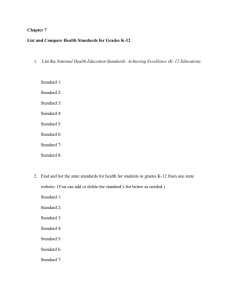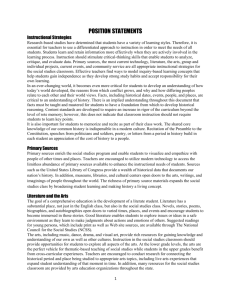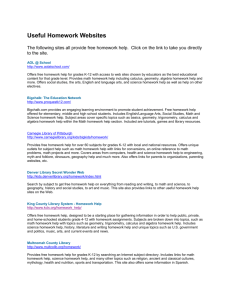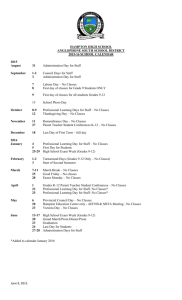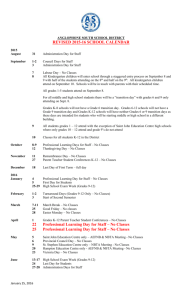Making space : teaching for diversity and social justice throughout
advertisement
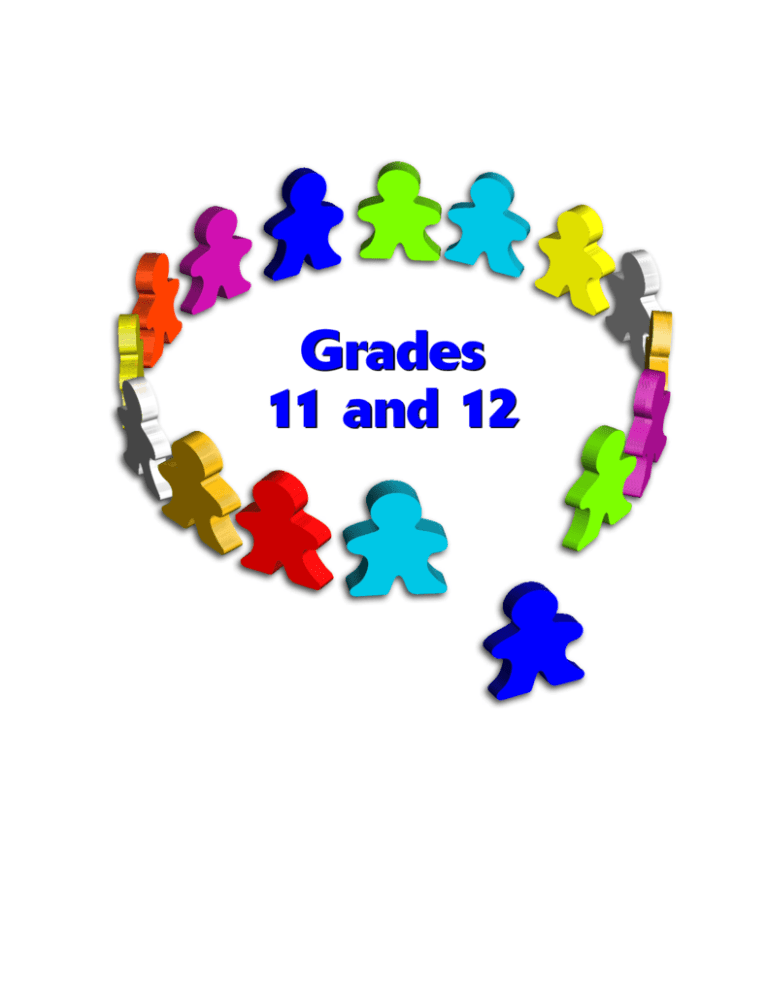
Grades 11 and 12 Curriculum Connections The following curriculum topics for Economics 12 relate to social justice: •• factors that affect growth, the creation of wealth, and the distribution of income in an economy •• various economic theories, including the theory of supply and demand, and their effect on the development of modern economic systems •• the effect of economic activity •• factors that can influence levels of employment in an economy •• how labour law, gender equity, affirmative action, and inclusion of minorities have changed labour as a factor of production •• the impact of government decisions and business decisions on factors of production •• why nations vary in terms of their economic development, including the effect of the global economy on Canadian markets •• the role of multinational corporations in shaping economic decisions and government policies •• the economic philosophies and factors behind government decision making. Grades 11 and 12 Business Education The following curriculum topics for Marketing 11 and 12 relate to social justice: •• how marketing affects consumer behaviour and vice versa •• how changes in economic, political, social, cultural, and legal factors influence marketing •• social, legal, and ethical issues involved in marketing products and services •• how governments assist and regulate businesses involved in international marketing •• how cultural values influence and are influenced by various marketing strategies •• the role of ethics and the law in the conducting of market research and in the use of marketing research data. Making Space: Teaching for Diversity and Social Justice throughout the K-12 Curriculum 63 Grades 11 and 12 Diversity and Social Justice Extensions Have students critique economic models and case studies from a social justice perspective. Encourage them to consider questions such as the following: •• How are resources obtained? •• Are the workers paid a living wage? •• Is there pay equity? •• Which skills are valued more? •• How is profit distributed? •• What local laws affect this case? Do these laws facilitate profit, protect workers and/or the environment, or both? Critiques of marketing case studies can consider questions such as the following: •• To what extent do the marketing practices exhibit diversity? •• Are campaigns that target specific markets (e.g., marketing laundry detergent specifically to women) a perpetuation of stereotypes, or simply realistic? •• Does the marketing campaign promote unhealthy, unsafe, or irresponsible behaviours? (e.g., unhealthy body image, over-consumption and waste) Discuss the extent to which businesses should be legally bound to be socially responsible and ethical in their business practices. 64 Making Space: Teaching for Diversity and Social Justice throughout the K-12 Curriculum Diversity and Social Justice Extensions Both Film and Television 11-12 and Theatre Performance 11-12 provide opportunities to connect to social justice themes when students are encouraged to •• study historical and contemporary examples of how theatre and film are used to promote social justice issues and effect social change •• study historical and contemporary examples of how theatre and film can perpetuate social injustice (e.g., depiction of stereotypes, propaganda) •• create and portray authentic characters that move beyond stereotypes •• identify examples of bias and stereotypes in drama works studied and viewed •• identify examples of lack of diversity in theatre and film works (e.g., diversity in relation to ethnicity, sexual orientation, family structures, sex roles, mental and physical ability, age) •• identify perspective and point of view in drama (including those brought to the work by the writer and those brought by the audience) •• consider how a drama work might have been different if a given character were a boy/man instead of a girl/woman or vice versa, had a different sexual orientation, ethnic background, socioeconomic status, etc. •• consider how viewing and responding to varied drama works can expand their experiences, challenge their assumptions and biases, and increase empathy and understanding •• create and perform drama works reflective of their own social justice interests or concerns. While directly challenging social assumptions may sometimes be appropriate, it may be more valuable to raise questions, instil awareness of alternatives, focus critical thinking on situations involving social justice, and reaffirm commitment to universal principles. Making Space: Teaching for Diversity and Social Justice throughout the K-12 Curriculum Grades 11 and 12 Drama 65 Grades 11 and 12 Using Existing Curriculum-Based Materials Film and Television 11 and 12 (1997) •• Sample 1, Grade 11: Producing a 30-Second Commercial (p. D-8)—In examining the form and content of commercials, focus on how the media can either promote or be a detriment to diversity and social justice aims. •• Sample 2, Grade 11: Documentary Production (p. D-11)— Discuss the power of documentary films to educate the public on social issues and effect social change. Encourage students to select documentary subjects that highlight and promote social justice issues. •• Sample 4, Grade 12: The Impact of Film and Television (p. D-20)—This unit provides opportunities to focus on the power of visual media as both a voice for and agent of social change. Select fiction and documentary films that address a range of social justice topics (e.g., racism, homophobia, antiSemitism, poverty, the power of the individual). Theatre Performance 11 and 12 (2002) •• Creating a Performance from Improvisation Exercises (p. C-13)—Select activities and improvisation topics for this unit that provide opportunities for students to explore a variety of perspectives on and solutions to conflict situations. This unit also helps students develop empathy through characterization. 66 Making Space: Teaching for Diversity and Social Justice throughout the K-12 Curriculum Curriculum Connections The English language arts curriculum at grades 11 and 12 includes prescribed learning outcomes related to •• use of oral language in a variety of situations and forms to convey and derive meaning •• reading and viewing texts in varied media, forms, and genres to develop thinking and understanding •• writing and representing in a variety of ways for a variety of purposes. Such expectations are readily compatible with a focus on social justice, since choice of content and text is largely up to the teacher. Indeed, selection of text (video or print, in any of the various genres) contributes significantly to the opportunities to discuss diversity and social justice issues. Grades 11 and 12 English Language Arts Appendix A lists a range of literature texts that might be considered as a springboard for teaching about diversity and social justice. English 12 First Peoples With its exclusive focus on literature created by First Peoples in Canada and around the world, this course provides additional curriculum expectations related to social justice. Specifically, the texts identified for use with English 12 First Peoples include themes such as •• the experience of colonization and decolonization (e.g., residential schools, the reserve system, land claims) •• the relationships between and among individual, family, and community •• connection with the land and environment •• the nature of knowledge—who holds it, what knowledge is valued. Making Space: Teaching for Diversity and Social Justice throughout the K-12 Curriculum 67 Grades 11 and 12 Diversity and Social Justice Extensions In addition to studying texts (including non-fiction print texts and audiovisual media) that deal fairly overtly with themes or situations relating to social justice concerns, English language arts teachers can use virtually any novel, story, or poem to teach a method of textual analysis (critical thinking) that will help further students’ awareness of social justice implications. Look for opportunities to examine social justice issues in relation to literature common to senior secondary ELA classes. For example: •• social roles for men and women and issues of power and authority in Shakespeare’s plays such as The Taming of the Shrew, Hamlet, and Macbeth •• the importance of social status in Arthur Miller’s Death of a Salesman, and parallels with today’s attitudes toward “success” •• the complicity of the broader society in injustice in Alice Munroe’s The Shining Houses (why is it easier to disregard the rights of another person if he or she is old, poor, eccentric, etc.?) •• mob mentality in Lord of the Flies—Is the violence in this novel exclusively a male phenomenon? Are there occasions when girls or women exhibit or have exhibited similar behaviours? Are there parallels in modern, “civilized” society? •• the present-day legacy of colonialism in North America in Green Grass, Running Water (Thomas King) or Monkey Beach (Eden Robinson). Experiencing and responding to varied dance, drama, music, visual arts, and literature works can expand students’ experiences, challenge their assumptions and biases, and increase empathy and understanding. 68 Additional opportunities to connect to social justice exist when students are encouraged to •• consider how reading and viewing varied texts can expand their experiences, challenge their assumptions and biases, and increase empathy and understanding •• identify perspective and point of view in texts (including those brought to the text by the author and those brought by the reader) •• look for ways in which the “silences” in texts—aspects of a story that are not developed—reflect assumptions or biases (including preoccupations or interests that are typical of a given author or period) •• examine characterization in particular for an indication of assumptions or bias (recognizing that a text may sometimes expose one form of oppression while accepting/ perpetuating other forms) Making Space: Teaching for Diversity and Social Justice throughout the K-12 Curriculum Making Space: Teaching for Diversity and Social Justice throughout the K-12 Curriculum Grades 11 and 12 •• consider how the narrative (i.e., in novels, stories, films) might have been different if a given character were a boy/man instead of a girl/woman or vice versa, had a different sexual orientation, ethnic background, socioeconomic status, etc. •• construct their own meanings from the material presented in or omitted from the text •• look for lessons of personal responsibility in relation to choices illustrated in a text (e.g., using Tom Wayman’s poem, Picketing Supermarkets, discuss what our responsibility is as knowledgeable, ethical consumers—once you are educated on an issue, is it acceptable to continue to act in ways that are harmful to others and to yourself?) •• study examples of how popular media (e.g., music, film, television, blogs, graphic novels) are used to promote social justice issues •• produce texts reflective of their own social justice interests or concerns (e.g., media messages, protest songs). 69 Grades 11 and 12 Sample Lesson Plan English 12 using The Crucible by Arthur Miller Some of this play’s themes (the dangers of rumours, fear mongering, and finger pointing) are certainly current today. The aftermath of September 11, 2001, is obviously still being felt. Blaming others out of fear and hysteria is all too common. One can see that any group can become the so called “witches” of the play: communists, terrorists, gays, Arabs, etc. Not understanding others or acting sanctimoniously or self-righteously will likely not bring about good will. Read the play and discuss how a lack of reason is allowed to exist. Not knowing the truth is what prevents reason from prevailing. What other fears do people have today that prevents them from acting in a reasonable manner? Tell the students about Maher Arar. What kind of political and social conditions existed in Canada and the USA that allowed an innocent man to be sent to Syria to be tortured? Have students select key lines from the play that underscore the following themes: •• Fear and ignorance lead to unreasonable behaviour. •• People’s real motives are not always apparent. •• Pointing the finger is easy; being honest is hard. •• Hiding from the truth may not be a good way to proceed. These ideas could then be incorporated into an essay about the play. Ask students to investigate the time and place in which Miller wrote the play (i.e., McCarthyism and the Blacklist). (Miller’s essay “Why I Wrote the Crucible,” is available online at www.honors.umd.edu/HONR269J/archive/MillerCrucible. html). Compare to post 9-11 “homeland security” laws and practices in both the US and Canada. 70 Making Space: Teaching for Diversity and Social Justice throughout the K-12 Curriculum English 12 using Paul’s Case by Willa Cather Pre-reading ideas: Ask students if they agree or disagree with the following statements, and to give reasons for their thinking. •• Living it up in a fancy hotel is a good way to escape from the daily grind. •• Daydreaming is a normal method of dealing with stress. •• The thought of getting a nine-to-five job makes me shudder. •• People who are different or weird are often the victims of bullying and harassment. •• It is important to help people who are on the verge of suicide. Grades 11 and 12 Sample Lesson Plan Have students discuss their thinking on these statements. Tell them the author will use the ideas in the story. Then have students read Paul’s Case. Post-Reading Questions: •• Why does Paul feel alienated? In what other ways do people feel alienated from society? •• What interventions could have been used to help Paul? •• What responsibility do the adults in the story have for Paul’s suicide? •• What details from the story may lead the reader to believe that Paul is gay? Are these stereotypes? What is this story saying about growing up not being able to be who you really are? •• Why might the author have been reluctant to be explicit about Paul’s sexual orientation? (e.g., considering when and where was the story written) •• Why does Paul always need fresh cut flowers around him? What do these flowers symbolize? •• If you were Paul’s friend, what might you say in an attempt to help him? •• What is the story saying about the apparent inability of society to deal with people who don’t fit in? •• If the story were set in today’s society, do you think Paul would experience the same sense of alienation? Why or why not? Have students research the correlation between adolescent suicide and homosexuality. What are the possible reasons for this statistic? (Note to teachers: while discussing this link, ensure students understand that homosexuality does not inevitably “cause” depression or suicide, but rather the high incidence is a result of overwhelming societal and/or family pressures and censures.) When teaching Paul’s Case, consider the idea of alienation or marginalization as a theme of the story. Attempt to have the students understand that Paul receives no help for his dilemma and thus turns to suicide, believing this to be his only option. Making Space: Teaching for Diversity and Social Justice throughout the K-12 Curriculum 71 Grades 11 and 12 72 Using Existing Curriculum-Based Materials English 12 First Peoples The Teacher Resource Guide for English 12 First Peoples includes the following units that provide a focus on social justice: •• Unit 1: Introduction to English 12 First Peoples •• Unit 5: Residential Schooling •• Unit 8: Research Essay •• Unit 12: Métis Literature Although developed specifically to support the implementation of English 12 First Peoples, many of the units in the Teacher Resource Guide—and the corresponding print, film, and audio learning resources—can be used for any English language arts course. This resource guide is available online at www.fnesc.ca/efp12. Making Space: Teaching for Diversity and Social Justice throughout the K-12 Curriculum Curriculum Connections The Family Studies 10-12 curriculum includes expectations related to •• the relationship between societal change and the changing definition of the family •• various family structures •• customs and traditions of families in various cultures •• how family values relate to the distribution and use of resources •• economic and social challenges that face families (e.g., financial challenges, political factors, prejudice and racism, media influences, urbanization) •• strategies for taking action on challenges facing families •• legal and financial rights and responsibilities in families •• characteristics of healthy and unhealthy relationships •• housing trends, economic and environmental influences on housing •• government involvement in housing •• home conservation practices. Grades 11 and 12 Home Economics The Foods 11 and 12 curriculum includes expectations related to •• the effects of food marketing practices on consumer behaviour •• global, environmental, and health issues related to the production and consumption of food. The Textiles 11 and 12 curriculum includes expectations related to •• ways to reduce the environmental impact of clothing and textiles •• historical, political, and cultural influences on fashion and textiles •• influences on fashion and textile choices, including ➢➢ socioeconomics ➢➢ media influences ➢➢ global and environmental considerations. Making Space: Teaching for Diversity and Social Justice throughout the K-12 Curriculum 73 Grades 11 and 12 Focus on Social Justice In Foods, have students select a particular food product and critique it from a social justice perspective. Have them consider questions such as the following: •• What ingredients were used to make this item, and where were they grown? Were they grown in an environmentally sustainable way? •• Does the item provide good nutritional quality? •• Where was the item manufactured? How was it transported to get here? •• How is the item packaged? Is the packaging environmentally responsible? In Family Studies, have students select a particular housing model and critique it from a social justice perspective. Have them consider questions such as the following: •• What features of energy conservation are present? •• What features of water conservation are present? •• Does this housing model provide for sharing of resources? •• What family structure(s) would be suitable for this housing model? •• Is this housing located conveniently for community resources? What are the implications of its location? In Textiles, have students select a particular clothing item and critique it from a social justice perspective. Have them consider questions such as the following: •• What fibres were used to make this item, and where were they grown or produced? Were they grown/produced in an environmentally sustainable way? •• How was the item manufactured? Were workers paid a living wage? •• Where was the item manufactured? How was it transported to get here? •• Do the item and the way it is marketed perpetuate an unhealthy body image? 74 Making Space: Teaching for Diversity and Social Justice throughout the K-12 Curriculum Curriculum Connections Learning outcomes in The Nature of ICT curriculum organizer include expectations related to •• moral, ethical, legal, and courteous approach to the use of technology •• becoming discerning users of mass media and electronic information •• technology to support collaboration and interaction with others •• the impact of technology on personal privacy. Human rights goals are guided by the principle that human rights violations are harmful to an entire community, and not simply to those who are oppressed. Grades 11 and 12 Information and Communications Technology Diversity and Social Justice Extensions Look for opportunities for students to consider the social justice implications of information and communications technologies. For example: •• What are the social justice implications of being ICT literate or not? •• Who “owns” information? Who doesn’t? What are the implications for those who own the information and those who do not? •• How are information and communications technologies used to promote social justice? (e.g., increased access to information and technology for geographically remote areas, access for people with physical disabilities) •• How are information and communications technologies used to perpetuate social injustice? (e.g., cyber bullying, hate-based web sites, manipulation and misrepresentation of information, propaganda) Making Space: Teaching for Diversity and Social Justice throughout the K-12 Curriculum 75 Grades 11 and 12 Music Diversity and Social Justice Extensions Music 11 and 12 courses provide opportunities to connect to social justice themes when students are encouraged to •• study historical and contemporary examples of how music— particularly popular songs—is used to promote social justice issues and effect social change •• consider how a song might have been different if the composer were a man instead of a woman or vice versa, had a different sexual orientation, ethnic background, socioeconomic status, etc. •• consider how listening and responding to varied music can expand their experiences, challenge their assumptions and biases, and increase empathy and understanding •• compose and perform music reflective of their own social justice interests or concerns. Using Existing Curriculum-Based Materials Composition and Technology 11 and 12 (1996) •• Sample 4, Grade 12: Culture in Your Community (p. D-20)— Extend this unit by discussing how the presence or absence of various types of music in the community reflects or fails to reflect diversity. Introduce the term “cultural imperialism.” Is a lack of diversity reflective of cultural imperialism, or simply an indication of popular taste? Are music tastes and preferences inherently biased? Choral and Instrumental Music 11 and 12 (2002) •• Choral Music 12: Concert Choir, Music Listening (p. C-22)— Include a focus on the lyrics in each listening sample. What do the lyrics say about the attitudes of the society of that time and place? Can we infer particular roles related to age, sex, or socioeconomic status? 76 Making Space: Teaching for Diversity and Social Justice throughout the K-12 Curriculum Curriculum Connections Science and Technology 11 With its focus on “engaging students in the investigation of scientific questions and the development of plausible solutions,” Science and Technology 11 offers multiple opportunities for students to think critically about the social justice implications of real-world science. Included in this course are curriculum expectations related to •• the tools and processes for producing and bringing food products to the consumer •• issues related to the safe use and disposal of chemicals found around the home •• the role technology plays in health issues and the influence of society on medical practices •• the technologies available to extract, process, and use natural resources •• the need for effective management of resources and the issues related to their impact on the environment •• technologies within the home and their impact on society. Grades 11 and 12 Science Diversity and Social Justice Extensions Biology 12 Investigate and discuss methods of reproductive technology such as in-vitro fertilization, sperm banks, embryo transplants, embryo freezing, and surrogacy. What is right? Who is right? Who decides? Making Space: Teaching for Diversity and Social Justice throughout the K-12 Curriculum 77 Grades 11 and 12 Social Studies Curriculum Connections Senior secondary social studies courses provide explicit (and in some cases mandatory) opportunities for students to address various social justice topics and issues. BC First Nations Studies 12 Learning outcomes that fall under the curriculum organizers “Contact, Colonialism, and Resistance” and “Leadership and Self-Determination” provide numerous opportunities to examine the dynamics of oppression as experienced by Aboriginal peoples in BC during the 19th and 20th centuries and to explore the ways in which First Nations individuals and communities have acted (are acting) to redress the situation. Specific curriculum topics relevant to social justice include •• economic, social, political, and cultural impacts of contact with Europeans on BC First Nations •• how post-Confederation government policies and jurisdictional arrangements affected and continue to affect BC First Nations •• the varied and evolving responses of First Nations peoples to contact and colonialism •• challenges during the 20th century that led to the emergence of contemporary Aboriginal leadership •• traditional and contemporary First Nations systems of governance •• contemporary legislation, policies, and events affecting the self-determination of Aboriginal peoples. Civic Studies 11 Civic Studies 11 learning outcomes mandate coverage of various topics that provide clear opportunities to address social justice issues and concerns within a Canadian and international context, including •• roles of individuals in society •• rights and responsibilities •• culture, language, heritage, and community •• human rights provisions in Canada and internationally •• fundamental principles of democracy 78 Making Space: Teaching for Diversity and Social Justice throughout the K-12 Curriculum In addition, students are expected to implement a plan for action on a selected local, provincial, national, or international civic issue. Comparative Civilizations 12 Comparative Civilizations 12 includes an examination of elements of culture such as belief systems, daily life, social roles, and power and authority in relation to various civilizations. As such, it provides clear opportunities to make comparisons and reflect on social justice issues. Specific curriculum expectations include •• the components of value systems within and among cultures, including religion and mythology, morals and ethics, heroes and role models, philosophical viewpoints •• the diverse values and beliefs of civilizations. Grades 11 and 12 •• the relative abilities of individuals, governments, and nongovernmental organizations to effect civic change •• the role of beliefs and values in civic decision making •• skills of civic discourse and dispute resolution •• the ethics of civic decisions. History 12 With its focus on 20th century economic, social, political, and military events, History 12 offers two especially evident opportunities to address social justice and diversity issues, as captured by the following curriculum expectations: •• the significance of the Holocaust •• key developments in the struggle for human rights in South Africa and the United States. Geography 12 Geography 12 includes a focus on Resources and Environmental Sustainability, which provides opportunities to address social justice and diversity issues. Specifically, students are required to •• assess the various considerations involved in resource management, including sustainability, availability, social/ cultural consequences, economic consequences, and political consequences •• assess the environmental impact of human activities, including energy production and use, forestry, fishing, mining, agriculture, waste disposal, water use. Making Space: Teaching for Diversity and Social Justice throughout the K-12 Curriculum 79 Grades 11 and 12 Law 12 Specific Law 12 curriculum topics relevant to social justice include •• concepts of law, including moral vs. legal issues •• the impact of human rights legislation on Canadian society •• issues related to family law, including cultural expectations, societal values, and economic factors. Social Studies 11 Social Studies 11 deals primarily with Canada-related topics and issues. Among the curriculum topics to be addessed, the following offer clear opportunities to address social justice and diversity: •• major provisions of the Canadian constitution, including the Charter, and its impact on Canadian society •• Canada’s participation in world affairs with reference to human rights and the United Nations •• Canada’s standard of living compared with those of developing countries, with reference to poverty and key indicators of human development •• the development and impact of Canadian social policies and programs related to immigration, the welfare state, and minority rights •• the role of women in terms of social, political, and economic change in Canada •• challenges faced by Aboriginal people in Canada during the 20th century and their responses, with reference to residential schools, reserves, self-government, and treaty negotiations. Social Justice 12 This course is designed to raise students’ awareness of social injustice, to encourage them to analyse situations from a social justice perspective, and to provide them with knowledge, skills, and an ethical framework to advocate for a socially just world. The course includes an emphasis on action, and provides opportunities for students to •• examine their own beliefs and values, as well as the origins of those beliefs •• support or challenge their beliefs and values through reflection, discussion, and critical analysis •• examine models of social change •• implement strategies to address social injustice and develop their capacities to effect positive change in the world. 80 Making Space: Teaching for Diversity and Social Justice throughout the K-12 Curriculum Social Studies 11 Begin with a quickwriting assignment: From the end of WWI to the 1960s, which groups of immigrants were “preferred” by the Canadian government? What evidence do we have to support this conclusion? What myths or common beliefs about immigrants exist today? Invite students to share their initial thoughts. Discuss as a class: •• What can our society do to facilitate an immigrant’s experiences in our community? •• Are there immigration policies or laws that can be changed? How? Using the Charter, have students look at historical incidents concerning the treatment of particular cultural groups—Komagatu Maru, head tax for Chinese immigrants, internment of Japanese-Canadians, War Measures Act, residential schools, etc. Continue the discussion to focus on more contemporary case examples—same-sex marriage, benefits for same-sex partners. What are the parallels? Grades 11 and 12 Sample Lesson Plan Have students prepare a news report about the incident representing the points of view of various stakeholders. Alternatively, have students form into groups to prepare and research for a debate (e.g., a mock parliament debating the given piece of legislation). Making Space: Teaching for Diversity and Social Justice throughout the K-12 Curriculum 81 Grades 11 and 12 Using Existing Curriculum-Based Materials Civic Studies 11 (2005) •• Unit 1: Active Citizenship (p. 57)—Include case examples and role models of active citizenship that promote diversity and social justice. Help students identify opportunities for focussing their citizenship action plans on projects and issues that promote diversity and social justice at the school, community, national, or international level. •• Unit 3: Rights and Responsibilities (p. 73)—Compare the classes protected under the Charter to those protected under other human rights legislation (e.g., the BC Human Rights Code). Which are the same? Which are different? What happens when there is a conflict between the two? •• Unit 4: Culture, Language, Heritage, and Community (p. 83)— Based on the cases studied (e.g., Anti-Potlatch laws, residential schools, internment of Japanese-Canadians, Chinese head tax, Meech Lake Accord, Bilingualism and Biculturalism Commission, Multiculturalism Act), have students reflect on the degree to which Canada is a nation that “honours diversity” and “promotes social justice.” •• Unit 6: International Relations (p. 99)—Based on case studies of interactions between Canada and other countries, have students identify the positive and negative effects for both countries from a social justice standpoint. Social Justice 12 (2008) All of the units provided for this course furthers students’ understanding of social justice topics and issues. In addition, many of these units can be adapted for use in other social studies courses. Social Studies 11 (2005) •• Unit 1: Political and Civic Processes (p. 46)—Focus on how civic processes have been used in the past to address social injustice and promote diversity (e.g., women’s suffrage, Aboriginal land claims, same-sex marriage and spousal rights, redress for internment of Japanese-Canadians, repayment of Chinese head tax). •• Unit 2: Canada and the Holocaust (p. 61), Unit 2: Canada and Human Rights Issues (p. 62), Unit 4: Immigration (p. 82), Unit 4: English-French Relations (p. 84), Unit 4: Aboriginal Peoples in Canada (p. 85), Unit 4: Canadian Identity (p. 86)—Based on these cases, have students reflect on the degree to which Canada is a nation that “honours diversity” and “promotes social justice. 82 Making Space: Teaching for Diversity and Social Justice throughout the K-12 Curriculum Diversity and Social Justice Extensions All visual arts courses at the grade 11 and 12 level provide opportunities to connect to social justice themes when students are encouraged to •• study historical and contemporary examples of how visual arts are used to promote social justice issues and effect social change •• study historical and contemporary examples of how visual arts are used to perpetuate social injustice (e.g., depiction of stereotypes, propaganda, marketing consumerism and overconsumption, glorification of violence) •• consider how a particular visual work might have been different if it had been created by a man instead of a woman or vice versa, if the artist had a different sexual orientation, ethnic background, socioeconomic status, etc. •• identify examples of lack of diversity in artists and the types of visual images present in society (e.g., diversity in relation to ethnicity, sexual orientation, family structures, gender roles, mental and physical ability, age) •• consider how viewing and responding to varied visual images can expand their experiences, challenge their assumptions and biases, and increase empathy and understanding •• create and display visual art works reflective of their own social justice interests or concerns. Grades 11 and 12 Visual Arts Using Existing Curriculum-Based Materials Media Arts 11 and 12 (1997) •• Media Arts 12, Sample 3: Creating a Visual Presentation on a Social Issue (p. D-15) Art Foundations and Studio Arts 11 and 12 (2002) •• Art Foundations 11: Using Digital Technology to Address a Social Issue (p. C-13) •• Art Foundations 12: Using Mixed Media—Art as Social Commentary (p. C-29) •• Studio Arts 11 (Ceramics and Sculpture 11): Examining Issues of Youth Culture through Figurative Sculpture (p. C-36) Making Space: Teaching for Diversity and Social Justice throughout the K-12 Curriculum 83
